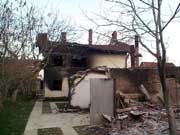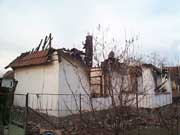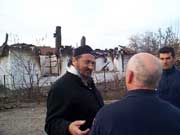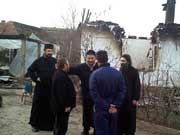|
|
NEWS
Information Service of
the Serbian Orthodox Church
March 20, 2004
REPORT
ON EVENTS IN LIPLJAN AND VICINITY DURING THE PERIOD FROM MARCH
17-19, 2004
In
the early evening on Wednesday, March 17, 2004 Albanian extremists
in Lipljan attacked the Serbs, the part of the Serb settlement
which is to the right (south) of the main road passing through
Lipljan from Pristina on the way to Prizren. At that time the
Albanians tossed hand grenades and shot at the Serbs, wounding
one man seriously (Nenad Vesic, born in 1950, who died of his
wounds) and injuring and expelling others. The Albanians then
headed in three groups of about 700 (a total of some 2,000) in
the direction of the Serbian churches in the northern part of
Lipljan, where there are about 800 to 1,000 Serbs living primarily
near two churches: the old medieval church of the Mother of God
and the new church of Holy Great Martyrs Florus and Laurus.

The
result of this extremist pogrom, which continued on Thursday,
March 18, is as follows: twenty-eight (28) burned Serb houses,
i.e., properties (which means 28 residences and an even greater
number of non-residential buildings in their yards). Among these
houses was the house of a painter whose walls still remain decorated
with the remnants of his burned paintings. In addition to Nenad
Vesic, about ten other people were wounded, among them the Lipljan
parish priest, Fr. Randjel Denic. People were expelled not only
from these 28 homes but from the whole of southern and part of
northern Lipljan.

According
to accounts by the priest and local Serb eyewitnesses who were
themselves targeted, the attack by the Albanian terrorists began
with Albanian policemen from the Kosovo Police Service expelling
Serbs from their homes, allegedly to protect them of the oncoming
masses but in fact to enable the Albanian extremists to more easily
set on fire the Serb houses and Serb residential quarters in Lipljan.
The mass of terrorists in three groups attacked from three sides
who were shooting and also armed with incendiary bombs, rifle
grenades and special missiles fired from rifles resulting in large
fires, as well as hand grenades and Molotov cocktails. In some
locations individual Serbs attempted to offer resistance but they
were surrounded by police, captured, tied up and taken to the
police station. As it advanced toward the churches, the mass screamed,
threw rocks and grenades at Serb houses in the street in the direction
of the church. When a hand grenade fell near an elderly Serb man,
KPS police rushed toward him, captured him and tied him up because
allegedly he had thrown the bomb! They did the same with Fr. Randjel
after a grenade was lobbed three or four meters in front of him
in the church courtyard; upon hitting the ground, the grenade
exploded and he was wounded by seven or eight pieces of shrapnel,
two of which inflicted cuts and flesh wounds to his chest, one
a cut to his forehead, and the others wounds to his arms and legs.
Luckily the injuries were not more serious and even though he
staggered and almost lost consciousness, he remained on his feet.
Hearing that the mass was approaching, Fr. Randjel with the help
of another man, had closed the gate on the church courtyard and
the door on the old church, and was withdrawing to his parish
home, which is on the north side of the church. Rocks were flying
at the windows of both churches and some of them were reaching
him and then the hand grenade was thrown, too. The extremists
crashed through the church gate and entered the courtyard and
continued to target the church with rocks. They did not succeed
in breaking into the church and setting it on fire because Finnish
and Czech KFOR arrived.

Before
the arrival of KFOR, Fr. Randjel, whose face and hands were bloody
from the shrapnel, entered his parish home to wash the blood off
his face and forehead. At that moment a few Albanian policemen
from the Kosovo Police Service ran in front of the terrorists
and, as if to surround the parish home from the front and before
the door, lay down on the ground with their pistols pointed at
the house. They shouted in Serb: "Hey you, get out of the
house!" When the priest appeared at the door, the policemen
demanded that he immediately lie down on the ground, to which
he replied: "Why?" "Because you are throwing grenades,"
they responded. "How could I have thrown a grenade when I'm
covered with blood from the shrapnel?" answered the priest
and refused to lie down on the ground. They forced him to raise
his hands and searched him for weapons then put handcuffs on him.
Then they broke into the parish home and searched it for weapons,
taking Fr. Randjel to the police station shortly before 18,00
hours. There they forced him to lie on the ground on his belly
even though his chest hurt from the shrapnel and he was bleeding.
They kept him there until 22,40 hours when a U.S. policeman came
and released him. The shrapnel wounds were still visible the afternoon
of Saturday, March 20, when we visited him between 16,00 and 17,00
hours. Other Serbs from Lipljan with shrapnel wounds are located
in the Simonida Hospital in Gracanica and in the hospital in Laplje
Selo.
Numerous Serbs from Lipljan fled toward Laplje Selo and Gracanica,
and 130 Serbs, including 15 children and 18 seniors, took refuge
in Suvi Do (on the other side of the main road). Other Serbs fled
to the northern part of Lipljan, where some of those who fled
to Laplje Selo and Gracanica are also returning. They have no
place to stay, no beds or blankets, and they also have no food.
On Saturday afternoon, when we visited them, there were distributing
the last remaining bread and food. (Their first meal of the day
was at 16,00 hours.) They are appealing for assistance in beds
and blankets because they intend to enter the Cultural Hall on
Sunday after Liturgy, and to stay there and receive other returning
refugees. It is not known if they will succeed in this because
the Cultural Hall has long been occupied by the Albanians. (Just
north of the Cultural Hall, next to the main road, there is a
secondary school completely occupied by the Albanians from where,
unfortunately, campaigns against Serbs are prepared every time:
attacks and well-known methods of terrorizing the remaining Serb
population in Lipljan, which prior to June 1999 was a small town
with a predominantly Serb population. (There were 6,000 Serbs
in Lipljan living in three-fourths of Lipljan, and about 1,500
to 1,800 Albanians living in the extreme southern part.)
On Saturday from 16,00 to 17,00 we, the undersigned, visited Lipljan
and spoke with Fr. Randjel and local Serbs. We then also visited
the burned part of Serb Lipljan, where smoke from smoldering fires
still can be seen. We took pictures of more than 10 burned houses
and other Serb buildings even though it is still risky to move
through Lipljan, including the torched area, because of a danger
from Albanian snipers. Finnish KFOR is protecting access to the
churches from two sides and Czech KFOR is also present. Serbs
say both contingents, despite being somewhat late, offered valuable
assistance. On the road near the burned houses we also saw a U.S.
policeman with whom we briefly spoke, and a Finnish soldier arriving
by jeep approached us and behaved correctly. Another Finnish soldier
who saw us Orthodox priests passing crossed himself in Orthodox
fashion. Serb locals whose houses had been burned showed us which
house had belonged to whom, and they told us that in one incomplete
two storey house where hay had been stored at the ground level,
and apartments were on the second floor, two Albanians had climbed
up to the apartments to loot them and set them on fire but other
Albanians who did not know they were there set the hay on fire,
burning down the house and the two Albanians.
We also reiterate the clear fact that the Albanian Kosovo Police
Service may have even been the organizer but was certainly the
precursor of extremism because it prepared the way for the Albanian
masses to carry out their pogrom against the Serbs and everything
Serb. Serb eyewitnesses state that they saw with their own eyes
how members of the Kosovo Police Service were laughing nearby
as extremists were setting fire to houses. We also wish to add
that the extremists are very well armed and equipped with everything
they need for rapid action; they can set a house on fire in no
time at all and from a greater distance than required to throw
a grenade or Molotov cocktail by firing some sort of rifle grenades
which cause quick fires.

This
report was prepared quickly immediately upon our return from Lipljan
and omits many of the details we heard on the scene and therefore
we have requested that Fr. Randjel Denic prepare his detailed
report.
As we were writing this report, we received word that yet another
Serb house in Lipljan, on the other side of the railway, was set
on fire and is still burning.
With this report we submit photographs of the burned houses.
In
Gracanica Monastery, on Saturday, March 20, 2004, at 19,00 hours.
Report
prepared by Atanasije of Herzegovina, Abbot Mihajlo of Sopocani
Monastery, Fr. Radivoje Panic and Fr. Nektarije.
|